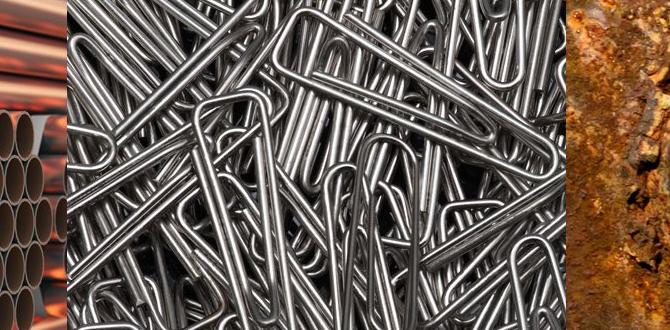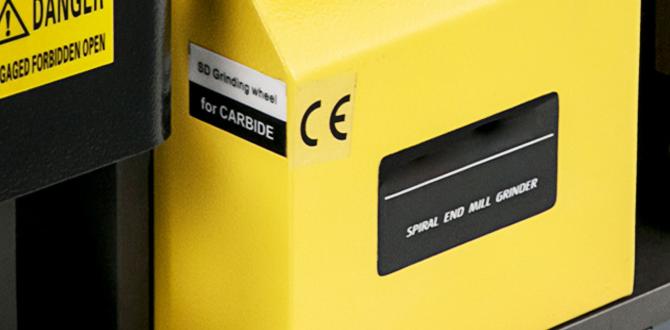A 3/16 inch carbide end mill is a crucial tool for cutting aluminum. Its sharp edges and hardness slice through the soft metal cleanly, preventing chatter and leaving a smooth finish. Look for ones specifically designed for aluminum, often with fewer flutes, to get the best results for your projects.
Welcome to Lathe Hub! If you’re diving into machining aluminum, you’ve likely discovered that working with this popular metal can be a bit tricky. It’s soft, which is great for shaping, but it can also gum up your tools, leading to frustrating results. But don’t worry, there’s a simple solution for clean, precise cuts: the 3/16 inch carbide end mill. This little tool is a workhorse for aluminum, and by the end of this guide, you’ll understand exactly why it’s so essential and how to use it like a pro. Let’s get your aluminum projects cutting smoothly!
Why a 3/16 Inch Carbide End Mill is Your Aluminum Best Friend
Aluminum is a favorite among makers and machinists for good reason. It’s lightweight, corrosion-resistant, and relatively easy to machine. However, its softness means it can easily stick to and clog standard cutting tools made from high-speed steel (HSS). This leads to poor surface finish, increased tool wear, and can even cause workpieces to seize up. This is where the 3/16 inch carbide end mill shines.
Carbide, or tungsten carbide, is an extremely hard and wear-resistant material. When formed into an end mill, it maintains a sharp cutting edge far longer than HSS, especially when dealing with softer metals like aluminum. A 3/16 inch size is incredibly versatile for common projects, from creating slots and pockets to profiling edges.
The Magic of Carbide for Aluminum
Carbide offers several advantages when machining aluminum:
Superior Hardness: Carbide is much harder than aluminum, allowing it to cut cleanly without deforming or clogging.
Heat Resistance: Machining generates heat. Carbide can withstand higher temperatures than HSS, extending tool life and maintaining cutting performance.
Sharpness Retention: Carbide tools hold their sharp edge much longer. This means more consistent cuts and less need for frequent tool replacement or sharpening.
Increased Cutting Speed: Because carbide is so robust, you can often run your milling machine at higher spindle speeds and feed rates when using carbide end mills, making your machining time more efficient.
Why 3/16 Inch Specifically?
The 3/16 inch (which is approximately 4.76mm) diameter is a very common size. It’s large enough for substantial material removal in many hobbyist and DIY applications, yet small enough to be used for detailed work like engraving, creating small pockets, or cutting intricate profiles. Many CNC machines and manual milling machines often come equipped with collets or holders that accommodate this size perfectly.
You might also see specifications like “8mm shank reduced neck for aluminum 6061 low runout.” Let’s break that down:
8mm Shank: This refers to the diameter of the part of the end mill that fits into your milling machine’s collet or tool holder. 8mm is a common metric size, and a 3/16 inch cutting diameter often pairs well with it.
Reduced Neck: Some end mills have a thinner “neck” section just above the cutting flutes. This can be beneficial for allowing the tool to reach deeper into pockets without the uncut shank rubbing on the workpiece.
For Aluminum: Many manufacturers design end mills with specific geometries (like the number of flutes and the helix angle) optimized for certain materials. An end mill “for aluminum” will typically have fewer flutes (often 2 or 3) and a higher helix angle to help with chip evacuation and prevent aluminum from sticking.
6061: This is one of the most common aluminum alloys. End mills designed for it will work well with most other common aluminum grades too.
Low Runout: Runout is the wobble or deviation of the cutting edge from its intended path. Low runout means the tool spins very true, leading to smoother finishes and more accurate machining. This is critical for precision work.
Choosing the Right 3/16 Inch Carbide End Mill for Aluminum
Not all carbide end mills are created equal, especially when it comes to aluminum. Here’s what to look for:
1. Number of Flutes
2-Flute: This is often the go-to for aluminum. The two cutting edges provide excellent chip clearance. As aluminum tends to produce long, stringy chips, having ample space for these chips to exit the cutting zone is crucial. This prevents clogging and re-cutting of chips, which degrades the surface finish.
3-Flute: Can also work well, offering a slightly better finish than a 2-flute in some applications due to their smoother cutting action. However, chip evacuation might be slightly less efficient compared to a 2-flute when cutting soft, gummy materials like aluminum.
4-Flute: Generally not recommended for soft aluminum. The tighter flute spacing makes it very difficult for aluminum chips to escape, leading to rapid tool loading, poor finish, and potential tool breakage.
2. Helix Angle
The helix angle refers to the steepness of the spiral flutes.
High Helix Angle (30-45 degrees): These are ideal for soft, gummy materials like aluminum. The steep angle helps to “shear” the material more effectively and lifts chips out of the cut more efficiently. This is sometimes called a “high-performance” or “up-cut” helix for aluminum.
Low Helix Angle (closer to 0 degrees): Better suited for harder materials where you want more support behind the cutting edge.
3. Coating
While not always necessary for aluminum, some coatings can further enhance performance:
Uncoated: Perfectly fine for aluminum, especially for hobbyist use.
ZrN (Zirconium Nitride): A good general-purpose coating that can provide a slicker surface, reducing friction and chip welding.
TiB2 (Titanium Diboride): An excellent choice for aluminum, offering extremely low friction and high hardness. It’s particularly good at preventing aluminum from sticking.
4. Material and Shank:
Solid Carbide: The end mill is made entirely of cemented carbide. This is the standard for good quality carbide end mills.
Shank Diameter: As mentioned, match this to your collet or tool holder. 8mm, 1/4 inch, and 6mm are common for this cutting diameter.
Table: Flute Count & Helix Angle for Aluminum
| Flute Count | Ideal for Aluminum? | Chip Evacuation | Surface Finish | Notes |
| :———- | :—————— | :—————- | :————- | :———————————————————————— |
| 2 | Excellent | Very Good | Good | Best for efficient chip removal; reduces clogging. |
| 3 | Good | Good | Very Good | Offers a smoother cut but slightly less chip clearance than 2-flute. |
| 4 | Poor | Fair | Fair | Prone to clogging and poor finish in soft aluminum; avoid for this task. |
Helix Angle: | Ideal for Aluminum? | Chip Evacuation | Notes |
| :——————————— | :—————————- | :—————— | :————————————————— |
| High (30-45 degrees) | Excellent | Excellent | Shears material effectively, lifts chips cleanly. |
| Medium (~20-25 degrees) | Fair | Good | A compromise, can work but may not be optimal. |
| Low (<20 degrees) | Poor | Fair | Not recommended for soft aluminum; prone to clogging. |
Setting Up Your Mill for Success
Once you have your 3/16 inch carbide end mill, proper setup on your milling machine is key to achieving great results and ensuring safety.
1. Secure the Workpiece
Vise: The most common method for holding aluminum. A sturdy milling vise is essential. Ensure the vise jaws are clean and that the workpiece is seated firmly and squarely against the vise’s fixed jaw.
Clamps: For larger or irregularly shaped pieces, T-slot clamps can be used, but they require more careful setup to ensure rigidity.
Double-Sided Tape/Adhesive: For very thin or sheet-like aluminum, sometimes a strong double-sided tape can be used in conjunction with clamps to prevent movement. However, this is less secure and usually reserved for lighter cuts.
Always use appropriate workholding. A spinning workpiece is an incredibly dangerous situation.
2. Install the End Mill Correctly
Cleanliness: Ensure the collet and the end mill shank are perfectly clean. Any chips, dirt, or oil can lead to runout and poor gripping.
Collet Selection: Use the correct size collet for your end mill shank. A 3/16 inch end mill will likely use a 1/4 inch or 8mm collet. Don’t try to force a slightly loose end mill into a collet.
Insertion Depth: Insert the end mill deep enough into the collet to ensure maximum support, but not so deep that it interferes with the machine’s spindle internals. A general rule is to have at least twice the cutting diameter of the tool held within the collet.
Tighten Securely: Tighten the collet nut firmly using the appropriate wrench. Then, tighten the drawbar (if your machine has one) to pull it up tight into the spindle taper.
3. Material Considerations (Aluminum Alloys)
While this guide focuses on aluminum in general, knowing your specific alloy can help fine-tune your settings. 6061 is common and relatively easy to machine. Softer alloys like 1100 or 3003 might be a bit “gummier.” Harder alloys (like 7075) will require slower feed rates and potentially different tool geometries. For beginners, sticking with 6061 or 3003 is a good starting point.
Machining Parameters for Aluminum with a 3/16″ Carbide End Mill
Getting the feed rate (how fast the tool moves into the material) and spindle speed (how fast the tool spins) right is crucial for efficient, clean cuts and tool longevity. These are often referred to as “cutting parameters.” Because speeds and feeds are so critical and depend on many factors, it’s best to start with conservative recommendations and adjust.
Starting Point Recommendations
Use these as a starting point for a typical 3/16 inch 2-flute carbide end mill cutting 6061 aluminum using a CNC or power feed. For manual milling (hand-feeding), you’ll need to adapt these to feel.
Table: Recommended Cutting Parameters for 3/16″ Carbide End Mill in 6061 Aluminum
| Parameter | Value (Typical) | Notes |
| :—————– | :—————- | :————————————————————————————————————————————————————————— |
| Spindle Speed (RPM) | 6,000 – 18,000 | Lower end for slower machines or larger cuts, higher end for faster machines and lighter cuts/finishing. Start conservatively. This is a wide range; consult tool manufacturer data if available. |
| Feed Rate (IPM)| 15 – 40 | This is the table feed rate. Adjust based on sound and chip formation. For manual milling, this translates to a consistent hand-feel. |
| Depth of Cut (Inches) | 0.020 – 0.060 | For roughing. Smaller depths are better for finishing or less rigid machines. |
| Width of Cut (Inches) | 0.030 – 0.187 (full slot) | Adaptive clearing tools (like HSM paths) will use much smaller widths, often a fraction of the tool diameter. For full slotting, use the full 0.1875 width. |
Important Considerations for Feed and Speed:
Machine Rigidity: A robust, rigid machine can handle higher feed rates and depths of cut. A lighter, less rigid machine will suffer from chatter and poor finishes if pushed too hard.
Tool Stick-out: The longer the end mill extends from the collet, the more it will deflect, reducing cutting efficiency and leading to chatter. Keep stick-out to a minimum.
Chip Load: This is the thickness of material removed by each cutting edge per revolution. A good chip load prevents the tool from rubbing and helps with chip evacuation. The feed rate and spindle speed are directly related to chip load. A common formula is:
`Feed Rate (IPM) = Spindle Speed (RPM) Number of Flutes Chip Load (inches per tooth)`
For a 3/16″ end mill, a chip load might be between 0.001″ and 0.003″ per tooth.
Sound and Chip Formation: These are your best indicators. Listen for a consistent, crisp cutting sound. Avoid high-pitched squealing (too fast) or a deep grinding/rubbing sound (too slow, or dull tool). Chips should be C-shaped or S-shaped, not fine dust or long, stringy bird nests. For aluminum, you want them to curl nicely.
Using Lubrication (Coolant/Cutting Fluid)
While some machinists can cut aluminum dry (especially with specialized tools), using a lubricant offers significant benefits:
Cooling: Reduces heat buildup, preventing tool damage and workpiece distortion.
Lubrication: Reduces friction between the tool and workpiece, leading to smoother cuts and better surface finish.
Chip Evacuation: Helps wash chips away from the cutting zone.
For aluminum, use a cutting fluid specifically designed for it. Soluble oils or synthetic coolants diluted with water work well. You can apply it via a spray nozzle directed at the cutting zone or use a flood coolant system if your machine has one. Some people also use isopropyl alcohol or WD-40 for very light cuts, but a dedicated cutting fluid is generally superior.
Speeds and Feeds for Manual Machining
If you’re using a manual milling machine, you’ll be controlling the feed rate by hand. This requires practice and a good feel for the cut.
1. Set Spindle Speed: Choose a spindle speed within the recommended range. Faster speeds are generally better for surface finish with carbide on aluminum, but your machine’s capability will dictate this.
2. Engage the Cut: Slowly and smoothly advance the quill (Z-axis) to set your depth of cut.
3. Feed into the Material (X/Y): Gently and consistently push the table or the workpiece into the spinning end mill. Try to maintain a steady PUSH, not a jerky motion. You should hear and feel a crisp cutting sound.
4. Listen and Feel: If the cut sounds like it’s chattering or the tool is rumbling, ease up on the feed pressure. If it sounds like it’s rubbing or scraping, you might need to feed slightly faster or take a deeper cut (if your machine is rigid enough).
5. Chip Formation: Observe the chips being produced. They should be thin shavings, not dust or smears.
6. Withdrawal: When you’ve completed the cut, smoothly withdraw the tool from the workpiece.
Manual machining requires developing a “feel” for the cut, and it takes practice! Don’t be discouraged if your first few attempts aren’t perfect.
Step-by-Step: Pocketing with a 3/16″ Carbide End Mill
Let’s walk through a common operation: cutting a rectangular pocket in a piece of aluminum stock using your 3/16 inch end mill.
Assumptions:
You have a piece of 6061 aluminum securely clamped in a vise.
Your 3/16 inch, 2-flute carbide end mill (with an 8mm shank, for example) is installed in the spindle.
You have your cutting parameters (speed, feed, depth) selected.
You are using a lubricant.
Steps:
1. Set Z Zero: With the end mill positioned just above the surface of your workpiece, jog the Z-axis down until the tip of the end mill is just touching the aluminum. This is your Z=0 reference point. For this operation, we’ll assume you want the pocket to be 0.100 inches deep. So, you will set your Z=0 on the surface and then go down to -0.100 inches.
2. Set X/Y Zero: Jog the end mill to the desired starting corner of your pocket. This is your X=0, Y=0 reference point.
3. Apply Lubricant: Start your coolant or spray your lubricant onto the intended cutting area.
4. Start Spindle: Turn on your spindle to the pre-determined RPM.
5. Engage the Cut (Plunge): Using a slow, controlled plunge feed (either manual or programmed), lower the end mill into the aluminum to your desired depth (e.g., -0.100 inches). Be careful during plunging – aluminum can grab if plunged too fast.
6. Begin Milling (X-Axis): Once the end mill is at full depth, begin feeding it into* the material along the X-axis (or Y-axis, depending on your setup). Maintain your target feed rate.
7. Follow Pocket Profile: Continue feeding the end mill along the programmed path, turning your pocket into existence. Ensure you are making full-width cuts or using an appropriate adaptive clearing strategy.
8. Complete the Cut: Work your way around the entire perimeter of the pocket.
9. Retract








